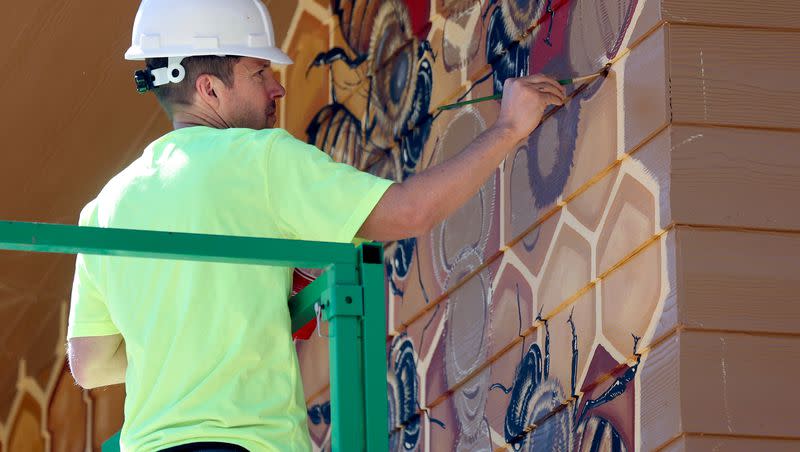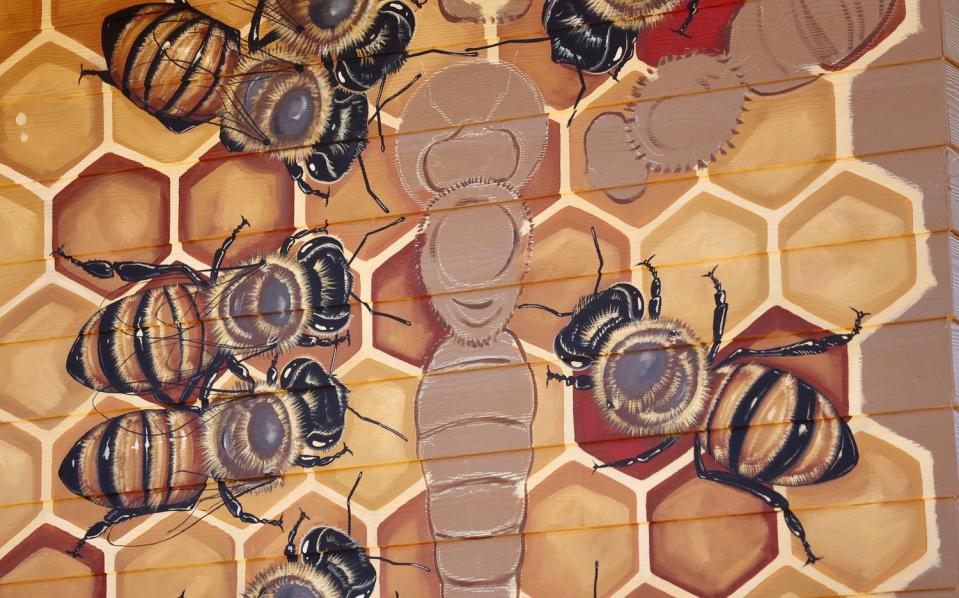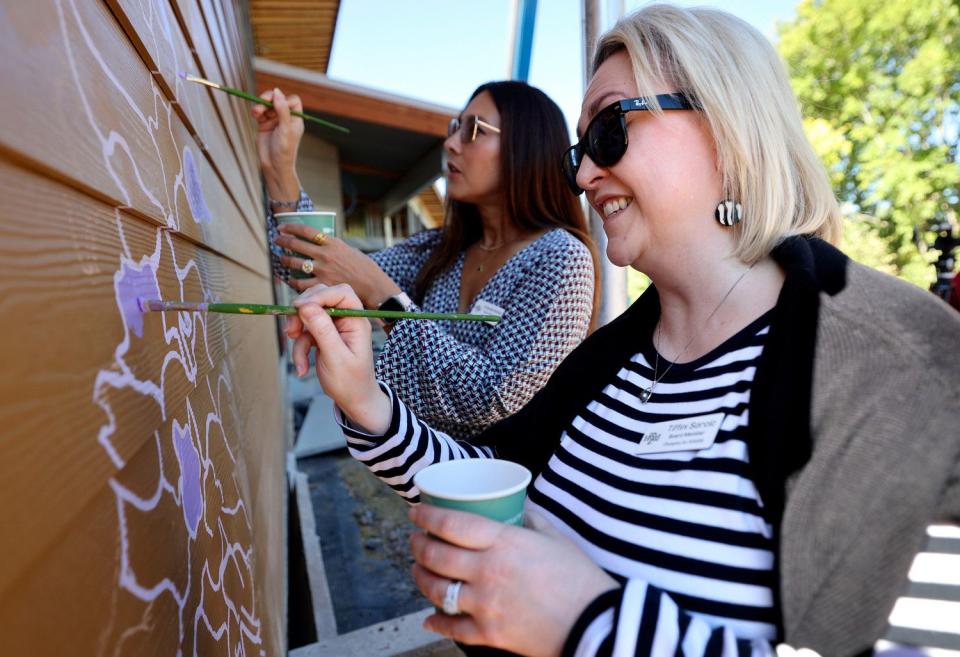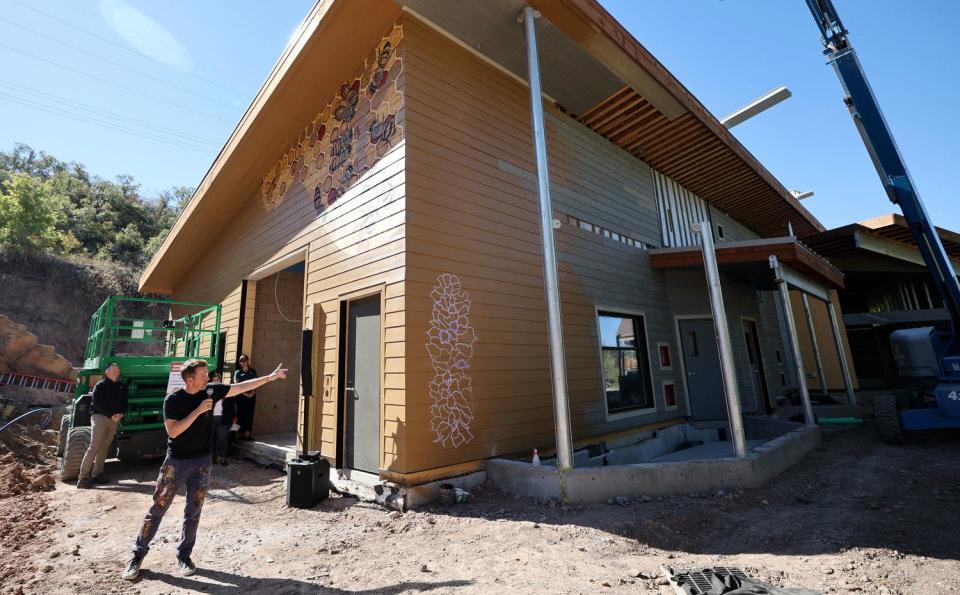Why a world-renowned artist is painting a bee mural at Utah's Hogle Zoo

For as much as Matt Willey knows of bees, he sheepishly admits he didn't know much about them well into his 30s.
That all changed when a honeybee crawled through an open window at his New York apartment one day in 2008. He knew something was wrong with the tiny insect when it walked around on a carpet instead of flying. Curious, he curled up on the ground next to it and watched it for an hour or two, examining its patterns and movements.
"There was a cuteness, like a little puppy-ness about the big eyes and antenna that really connected me," he said Tuesday, recalling the moment. "And I heard this weird voice that something like, 'This is just about change, another form of change.'"
Willey, an artist who has painted murals depicting all sorts of subjects over the globe, put the bee out into his backyard where it later died. However, having that interaction inspired Willey to learn more about bees and ultimately changed the subject of his work.
He discovered that the bee likely came to his home after falling ill and deciding to leave its hive well aware of its pending mortality, a practice bees do to protect the health of the hive. This led him down a long rabbit hole into the roles bees play in doing what's best for their community, a perfect metaphor for human society.
He also learned about the global collapse of bees and the human ramifications for that. All of this sparked an ambitious goal to paint 50,000 individual bees through murals as a part of his art initiative called The Good of the Hive.
"It's really looking at using the metaphor of the hive to then speak about all the things that connect us," he added. "It was like a lightning moment for me. I started walking around Manhattan, like 'We're like this too.'"
Willey has since reached one-fifth of his goal, painting realistic-looking bee murals across the world. Some of his recent work is being completed in North Carolina and Louisiana after he wrapped up a mural in China last year.

He is also working to create a new mural at Utah's Hogle Zoo, his first mural in the Beehive State — a nickname created to reflect the cooperative spirit pioneers had after settling in the state much in the way Willey noticed life after his bee interaction.
His goal is that it will stop zoo visitors in their tracks, potentially seeing bees in a new light the way he did 15 years ago.
A bee mural in the Beehive State
Willey has already added about a dozen honeybees toward his 50,000 goal on the side of the forthcoming Norma W. Matheson Education Animal Center, a part of the new Aline W. Skaggs Wild Utah exhibit now set to open in the spring. The mural is still under construction, though.
Liz Larsen, vice president of programs at the zoo, says the idea fits well with the goal of the center. It will feature all sorts of animals Utahns can find in nature with native creatures that can't be released into the wild for one reason or another, like a badger, a pair of cougars and several amphibians. It also will feature plenty of bees, as the state is home to more than 1,000 different species.

The animals that will be housed here are similar to the ones that Utah second graders learn about as a part of the state's public education curriculum, but the exhibit also aims to offer visitors a different, up-close experience with native creatures so that Utahns may be inspired to care more about them and their habitats in the future.
"Guests will have the opportunity to learn about wildlife (and) to gain a greater appreciation for wildlife as an important (part) of the natural beauty of our state," Larsen said, standing inside the partially completed building Tuesday. "This exhibit in here will have all sorts of unexpected surprises and delights for our guests."
Using art to educate
This is also where Willey's mural factors into the overarching goal. Larsen says the zoo aims to bring people together as one for a common goal — in this case, wildlife conservation.

It's estimated that bees and other pollinators help pollinate three-fourths of the world's flowering plants and more than one-third of all global food crops, according to the National Institute of Food and Agriculture. But many beehives have struggled in recent decades as a result of several factors, including the rise of invasive species, new diseases, pesticide poisoning and habitat changes, the Environment Protection Agency notes.
A University of Maryland and Auburn University survey found that 48% of all U.S. bee colonies were lost over the past year, the Associated Press reported in June. Nathalie Steinhauer, the survey's lead author, told the AP there isn't a "bee apocalypse" underway, but the situation is not improving either.
These are things that Willey hopes people will consider when they view his mural. He knows it won't solve the problems bees face, but it may get people to think about bees differently as they dwell on the subject, much like he did in his New York apartment.
"One of the things that art does is it asks questions," he said. "It doesn't give you an answer. I'm not telling anyone what to think."

